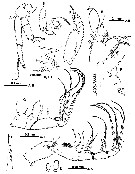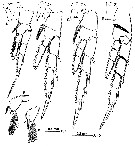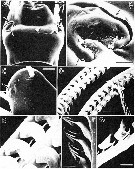|
|
 |
Fiche d'espèce de Copépode |
|
|
Calanoida ( Ordre ) |
|
|
|
Arietelloidea ( Superfamille ) |
|
|
|
Arietellidae ( Famille ) |
|
|
|
Scutogerulus ( Genre ) |
|
|
| |
Scutogerulus boettgerschnackae Ohtsuka & Boxshall, 2004 (F) | |
| | | | | | | Ref.: | | | Ohtsuka & Boxshall, 2004 (p.50, Descr.F, figs.F) |  Issued from : S. Ohtsuka & G.A. Boxshall in Syst. Biodiv., 2004, 2 (1). [p.50, Fig.1]. Female (from 26°19.18'N, 127°25.56'E): A-B, habitus (dorsal and lateral, respectively); C, posterior margin of prosome and genital double-somite (lateral); D, forehead with rostrum (ventral); E, urosome and posterior margin of prosome (dorsal); F, genital double-somite (ventral view; gonopore indicated by large arrowhead and copulatory pore indicated by small arrowhead); G, genital system, gonopore (indicated by large arrowhead) and copulatory pore (small arrowhead); H, A1, first (I-II) to 16th (XVIII) segments (posterior row of setules missing); I, A1 17th (XIX) to 23rd (XXVI-XXVIII) segments; J, posterior row of setules of first three segments; K, last two antennulary segments (XXIV-XXV and XXVI-XXVIII). Nota: - Prosome 2.5 times longer than urosome. - Cephalosome incompletely fused to 1st pediger, 4th and 5th pedigers completely fused. - Posterolateral angles of prosome ends produced into round processes reaching beyond middle of genital double-somite. - 2nd and 3rd pedigers each produced postero ventrolaterally into round projection. - Urosome 4-segmented. - Genital double-somite swollen laterally at midlength. Genital system paired and symmetrically arranged; gonopore and copulatory pore sharing common slit, located anteriorly and posteriorly, respectively; seminal receptacle compact. - 2nd urosomite nearly as long as 3rd. - Caudal rami symmetrical, inner margins ornamented with fine setules; minute seta I located anterolaterally; seta V longest; seta VII originating dorsally from inner distal corner. - A1 indistinctly 23-segmented, extending to distal margin of 3rd urosomite.
|
 Issued from : S. Ohtsuka & G.A. Boxshall in Syst. Biodiv., 2004, 2 (1). [p.52, Fig.3]. Female: A, A2; B, exopod of A2; C, Md (cutting edge); D, Md palp; E, Mx1; F, Mx1 basis and endopod (vestigial seta on basis arrowed); G, Mx2; H, basal spine of Mx2; I, Mxp (with setae a and b labelled); J, seta of mxp endopod with modified 'shield-shaped' setules; K, two apostome phoronts (?) on maxillipedal setae. Nota: - A2 with 2-segmented endopod and indistinctly 9-segmented exopod; setal formula of exopod 0, 0, 1, 1, 1, 1, 1, 0, 3; proximal endopodal segment unarmed, distal segment with 2 unequal setae subterminally (representing armature of 2nd endopodal segment) and 5 setae terminally. - Md cutting edge with 1 mono-, 1 bi- and 1 tri-cuspidate teeth and 2 patches of short spinules. Md palp with basis bearing row of setules; endopod rudimentary, 1-segmented, with 2 unequal setae terminally; exopod 5-segmented, setal formula 1, 1, 1, 1, 2. - Mx1 with praecoxal arthrite bearing 1 short process, 4 spinulose spines and row of fine setules; coxal epipodite with 6 setae; coxal endite with 1 long spinulose seta; basis bearing 1 vestigial element (see fig.3F arrowed) and 2 rows of fine setules; endopod bulbous, with 1 short, spinulose seta terminally; exopod lamellar, with 3 long, plumose setae at tip. - Mx2 relatively delicate in comparison to those of other arietellids; 1st praecoxal endite with 1 spinulose seta and rudimentary element; 2nd praecoxal endite with single seta; 1st and 2nd coxal endites each with 2 spinulose setae; basis bearing stout, spinulose spine (fig.3H); endopod 4-segmented, setal formula 1, 3, 2, 2; all endopodal setae ornamented with row of modified 'shield-like' setules. - Mxp with syncoxa bearing 3 spinulose setae subterminally; basis with 2 spinulose setae and dense patch of short spinules; 1st endopodal segment incompletely incorporated into basis, with 1 spinulose seta; 2nd to 6th endopodal segments with setation 4, 4, 3, 3, 4, including 1, 1, 2, 2, 2 shield-like setae, respectively; setae 'a' nand 'b' rudimentary.
|
 Issued from : S. Ohtsuka & G.A. Boxshall in Syst. Biodiv., 2004, 2 (1). [p.53, Fig.4]. Female: A, P1 (anterior); B, P2 (anterior); C, P3 (anterior); D, P4 (posterior; E, right P5 and intercoxal sclerite; (anterior; arrowhead showing putative vestigial exopod); F, left P5 (posterior). Nota: P5 nearly symmetrical, each leg consisting of lamellar plate incompletely fused to intercoxal sclerite; lamellar plate with long plumose seta subterminally and shorter one on posterior surface; small, subterminal or terminal knob on each plate possibly representing exopod (see in SEM micrographs fig.2C).
|
 Issued from : S. Ohtsuka & G.A. Boxshall in Syst. Biodiv., 2004, 2 (1). [p.53]. Female: Setal and spine formula of swimming legs P1 to P4. Spines are denoted by Roman numerals and setae by Arabic numerals.
|
 Issued from : S. Ohtsuka & G.A. Boxshall in Syst. Biodiv., 2004, 2 (1). [p.51, Fig.2]. Female (SEM micrographs): A, genital double-somite, ventral view, gonopores and copulatory pores indicated large and small arrows, respectively, left side damaged; B, right gonopore (indicated by large arrow) and copulatory pore (by small arrow); C, left P5, anterior surface, vestigial exopod (?) indicated by arrow; D-G, 'shield setae' on maxillary endopod. Scale bars: 0.1 mm (A); 0.01 mm (B, D); 0.02 mm (C); 0.002 mm (E-G).
| | | | | NZ: | 1 | | |
|
Carte de distribution de Scutogerulus boettgerschnackae par zones géographiques
|
| | | | | | | Loc: | | | East China Sea (Okinawa: off Kuroshima Island).
Type locality: 26°19.18' N, 127°25.56' E. | | | | N: | 1 | | | | Lg.: | | | (980) F: 2,79-3,01; {F: 2,79-3,01} | | | | Rem.: | hyperbenthic (596-606 m).
For Ohtsuka & Boxshall (2004, p.54) the following phylogenetically important, generic characteristics are reconfirmed by the discovery of this new species: 1- the primitive female genital system (plesiomorphy); 2 - the presence of modified 'shield-shaped' setules on the setae on the maxillary and maxillipedal endopods (autapomorphy): 3 - the loss of the outer distal spine from the first exopodal segment of P1 (autapomorphy). The type of female genital system in which a gonopore and a copulatory pore share a common slit is retained in the most primitive calanoid family Pseudocyclopidae and probably in the Boholinidae. In the Arietellidae only Scutogerulus retains such a system. This symplesiomorphy has previously been regarded as evidence of a close relationship between the Arietellidae and the Pseudocyclopidae by Andronov (1974), Park (1986) and Bradford-Grieve (2002). | | | Dernière mise à jour : 08/03/2015 | |
|
|
 Toute utilisation de ce site pour une publication sera mentionnée avec la référence suivante : Toute utilisation de ce site pour une publication sera mentionnée avec la référence suivante :
Razouls C., Desreumaux N., Kouwenberg J. et de Bovée F., 2005-2025. - Biodiversité des Copépodes planctoniques marins (morphologie, répartition géographique et données biologiques). Sorbonne Université, CNRS. Disponible sur http://copepodes.obs-banyuls.fr [Accédé le 25 décembre 2025] © copyright 2005-2025 Sorbonne Université, CNRS
|
|
 |
 |







